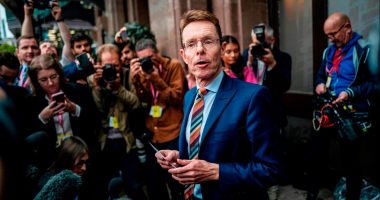“Levelling up” was the buzzword of the UK’s December 2019 general election campaign, but it was only after Boris Johnson had secured an 80-seat majority that thoughts turned to how to actually achieve it.
Johnson was “passionate” about the idea of reducing regional inequalities, according to multiple colleagues. But when asked what levelling up meant in practice, the then prime minister joked to one aide that he wanted to see a Waitrose supermarket and an opera house in every town in the country. Colleagues were left to sort out the details.
“It became clear that Boris’s people hadn’t done any thinking on it at all,” said one former Tory aide, adding that Johnson’s most senior advisers thought the concept risked becoming a political millstone.
It took nearly two more years for “levelling up” to crystallise from a general promise into the detailed policy agenda announced by levelling up secretary Michael Gove in a February 2022 white paper.
The ambitious document promised to devolve more power to local governments while helping them catalyse economic growth via freeports, low-tax investment zones and a multitude of funding pots dishing out grants to local authorities.
More than £10bn has been allocated for “levelling-up funds” in the five years to 2025-26. Yet the government has only made partial progress towards achieving its ambition.
“We have always stressed that it is a long-term process, regional economic inequality has been an issue since the 1920s and won’t be resolved overnight,” Gove told the Financial Times. “But we are making significant progress . . . there is still a lot to do but a lot has been done.”
Economists point out that the picture is muddied by contradictory data. On some measures regional disparities have widened; on others they’ve narrowed, making it easy for politicians to cherry-pick data to support their own narrative of success or failure.
Legacy of levelling up

The Conservatives rode to victory in 2019 on an ambitious pledge to reduce the UK’s long-standing regional inequality. This story is the first in a series that delves into the impact of ‘levelling up’ and its future as the next general election approaches
Part one: Inside the multibillion-pound plan to help left-behind towns
Part two: The benefits and drawbacks of levelling up
Part three: Can a freeport ‘level up’ the Welsh island of Anglesey? Senior Downing Street and Treasury advisers gathered in January 2020 to discuss how to take the new levelling up agenda forward and began to thrash out a plan. Then the pandemic hit.
“It’s pretty clear overall that levelling up, in outcomes broadly understood, has not happened, if you take headline measures like output per hour, health, the ultimate standard of living measures”, said Diane Coyle, Bennett professor of public policy at the University of Cambridge.
She added: “I’m very comfortable with saying there hasn’t been any progress on levelling up. Although when you go down to specific metrics you will get more of a mixed picture.”
The government can point to some achievements, however. Ministers have now rolled out freeports in England and Wales, which Gove told MPs in January had so far attracted £2.87bn in investment — £2.15bn of which is from international sources — and created 5,700 jobs.
The government has also increased arts spending outside the capital for the 2023-26 period (and has not renewed around £50mn in grants to cultural organisations in London, to their fury). Likewise research and development spending has been tilted somewhat away from the South East, although the relevant data does not yet cover the period.
At the same time, plans to relocate civil service roles out of the capital have accelerated, with more than 18,000 official positions moved to the regions since a programme called Places For Growth was announced in 2018.
In real terms, transport spending in London and the South East has fallen by £12 per head — and risen by £35 in other regions.
The government has struck devolution deals with a number of areas including North of Tyne, West Yorkshire, East Midlands and York & North Yorkshire.
This means that nine out of 10 people in northern England are now covered by a devolution deal, while in the whole of England 64 per cent of the population lives under a devolved authority — up from 41 per cent two years ago — with powers over areas such as investment, transport and adult education.
But most of these achievements come with caveats.
Opponents say freeports simply displace investment from one place to another and note that so far barely 10 per cent of the funds allocated to the levelling up programme has been spent, according to a recent report by parliament’s public accounts committee.
They also point out that the devolution of civil service roles has not made up for the huge centralisation in Whitehall between 2010 and 2021, when official roles outside London were cut by 58,005 even as the number in the capital rose by 15,401.
Critics also describe a “Hunger Games-style” competition for levelling up funding which does not make up for the severe cuts to local government grants over the last 14 years.
Despite devolution, local government has received a rapidly falling share of total public spending as central grants to local authorities have been slashed from 30 per cent of public spending in England in 2010 to 20 per cent in 2022-23. Those cuts far outweigh the individual levelling up funds.
Angela Rayner, shadow levelling up secretary, said the Tories had correctly identified a problem around regional inequalities. But she added that “levelling up as they implemented it has been a sham and a scam”.
“They took out huge amounts of money from local government and then pitched councils against each other to bid for little pots of money which put a few nice planters in town centres but really didn’t fundamentally deal with the inequalities around skills, housing, employment and transport,” she said.
Clive Betts, the Labour MP who chairs parliament’s levelling up select committee, said he was not convinced that the “entire machine” of government was committed to the issue.
“I think Gove believes in it, the question is whether any other government departments are putting their weight on this agenda . . . it has to be across government, this effort,” he said.
Data examined by the FT shows areas outside London and the South East going into reverse compared to the capital on some of the yardsticks set by the government in its 2022 white paper.
For example, in 2019 London and the South East were lagging behind the rest of the country on gigabit broadband provision. Now they are ahead.
Between 2019 and 2023, schools in London and the South East extended their lead on GCSE results in English and Maths from 4.6 percentage points to 5.6 percentage points. Even though the percentage of Key Stage 2 pupils attaining an “expected” standard of Maths and English has dropped across the board, the gap in attainment between London and the South East and the rest of the country has remained constant.
On health, Covid was responsible for a drop in healthy life expectancy between 2019 and 2022 in every region except for London.
The government included the number of people getting on the housing ladder as measure of success in levelling up. However, the number of first-time home buyers jumped from 14.1 to 20.4 per 1,000 in London between 2019 and 2023, while elsewhere it only rose from 12.7 to 14.4 per 1,000.
The gap in real-terms pay between the capital and the rest of the country has narrowed slightly, but only because of a real-terms fall in London rather than increases elsewhere.
The regional disparity in productivity, measured by gross value added per hours worked, remained exactly the same between 2019 and 2021, with London and the South East remaining 37 per cent more productive than the rest of England.
Moreover, the capital not only has the highest employment rate but has extended its lead over other regions. In 2023, the share of over-15s in work was 4.4 percentage points higher in London and the South East than elsewhere, compared with 4.2 percentage points in 2019.
Adrian Pabst, deputy director at the National Institute of Economic and Social Research, said there had not been much “overall” progress on levelling up.
“Levelling up is a generational task that requires sustained political leadership and investment at scale,” he said. “But overall there hasn’t been much progress. In some areas of the country, in fact, the situation has got even worse.”
With expectations of a change in government after the election, the Labour party has signalled that it would devise a new term to describe its mission to reduce regional inequalities. The levelling up department would probably be rechristened, shadow ministers say.
Pabst said senior Labour frontbenchers understood the need for a different approach but added that “at this point Labour lacks the imagination and the determination to do anything about that”.
“Sustained regional regeneration requires political leadership, in particular prime ministerial commitment,” he said.
Coyle agreed that a Labour government would face a “big task” in regenerating England’s regions.
“If I was in Labour, I’d be being quite cautious in terms of potential outcomes,” she said. “When it comes to the scale of this challenge, 10 years is if anything on the short side.”
Read More: World News | Entertainment News | Celeb News
FT












